Thank you for visiting HOJO website. If you have any enquiry, please feel free to get in touch with us at
▼ Akira Hojo
▼ Hojo Newsletter
▼ HOJO FACEBOOK





HOME Tetsubin: Japanese Cast Iron Kettle
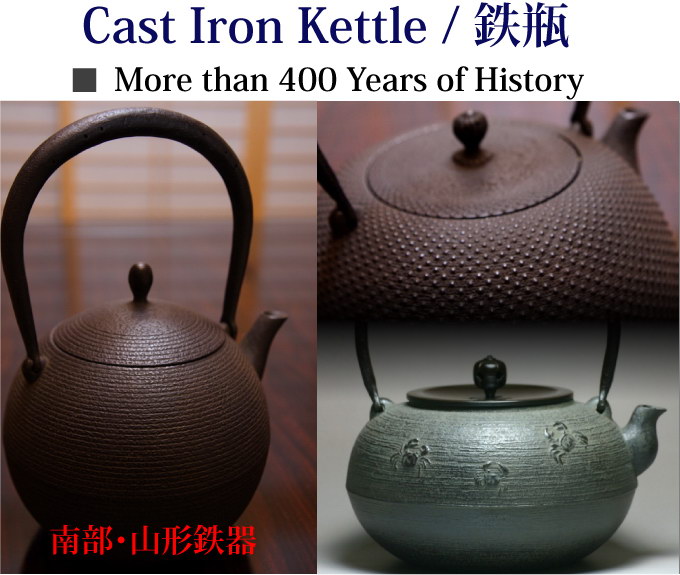
The Cast Iron Kettle: called a "Tetsubin" in Japanese, has been produced in Japan for hundreds of years. It is traditionally a hand crafted object that was developed as an utensil for use in the Japanese Tea Ceremony. These Cast Iron Kettles are made by pouring molten iron into either clay or sand molds. Clay molds are used in the production of high-end artisanal Tetsubin products, while those Tetsubin mass produced by the hundreds using sand molds are destined for common commercial sales and export.
The function of the Tetsubin is unique. It significantly changes the taste of water. When brewing tea using water boiled in Tetsubin, the taste of the tea becomes very mellow and sweet. In addition, thanks to the iron content of the kettle, the resultant water gives us additional health benefits
The Tetsubin is meant for boiling water. Using boiled water from the tetsubin to brew tea, the taste of tea, in particular, the intensity of the after taste of the tea changes. If you have never tasted water boiled in a Tetsubin before, you are without a doubt, about to experience the taste of water as you have never imagined it could be .
The water boiled in a tetsubin is not only suitable for the preparation of tea. It can be utilized as simple drinking water; as water for the making of coffee; or even as water in the making soup or commercial products like Cup O'Noodles. As you will see, the taste of the water produced in a Tetsubin is uniquely different from that of water boiled in any other ordinary cooking device.
The chemical structure of water is part of the key that explains how water changes when boiled in a Tetsubin. The water molecule (H2O) consists of two elements, hydrogen (+)and oxygen (-).These elements carry both positive and negative electrical affinities or charges, just like a magnet. This is called dipole in Chemistry. These equal electrical charges, that exist on both oxygen and hydrogen, cause water molecules to constantly spin when in a liquid state . If they stop spinning, then water will become ice. Variable intensity of hydrogen bond allows the flavor and texture of water to change depending on the instrument utilized when boiling it. For example, if there is no mineral content in the instrument utilized to boil the water, for instance, a sterile glass beaker, the positive and negative charges of the elements of the water molecule will simply be attracted to each other and form their network or molecule through their hydrogen bonds. These bonds give water it's characteristic viscosity and surface tension, but a plain or flat flavor. However, when minerals exist in the instrument utilized to boil the water, for example, the Tetsubin, the elements of the water molecule are attracted to the minerals from the Tetsubin instead. In fact, the affinity of the water molecule with certain types of minerals in the Tetsubin is stronger than those existing between the water molecules themselves. Minerals and water molecules form more stable bonds. This stronger attraction between minerals and water molecules also increases the viscosity and surface tension of the water. This effects our perception of the flavor and texture of the water itself, and most importantly, our taste buds can feel more taste, and a taste that stays longer in our mouths thanks to the stronger attraction of these hydrogen bonds and the metal ions of the Tetsubin.
The presence of minerals also affects the depth of the water's flavor. Minerals attract volatile flavor producing substances and form stronger hydrogen bonds in water. The stronger these hydrogen bonds are, the slower the evaporation of such volatile substances becomes. As the result of slow evaporation, we feel a much deeper and longer lasting flavor in our mouth.
All of this being said, it becomes obvious that the taste of the water boiled in the Tetsubin will differ depending on the water one chooses to use. Different waters contain different types of minerals effecting each water's composition, and hence the water's flavor and physical sensation or taste.
In general, the use of a Tetsubin will enhance the taste of the water used. It will give your water a pleasant after taste and long lasting flavor. For tea drinkers who are seeking to enjoy a stronger after taste in their tea, a Tetsubin is suitable for all types of tea. In addition , it will reduce the unwanted aromas of your water. Usually, the first thing that a novice Tetsubin user tends to appreciate is the change in the aroma of his tea, rather than the actual taste. Frankly speaking, you do not need a Tetsubin if you just want to enjoy the aroma component of your tea. However, if you compare two different cups of tea, one brewed with water from a Tetsubin, and one brewed in a stainless steel teapot; you will find that the cup brewed using water from a Tetsubin will definitely have a deeper aroma and flavor.
As to the taste of one's tea, the effect that the Tetsubin has on the taste of the water, and hence the tea, differs from one Tetsubin brand to another. This is due to the difference in the raw materials used and the techniques applied in the making of the Tetsubin. The surface area (porosity) plays a significant role. This will be discussed in subsequent sections of this site.
The Tetsubin has been made in Japan since the Sixteenth Century. When we use the word “Tetsubin”, in Japanese, we are referring to a kettle that is used only to boil water. The interior is either bare iron or only coated with Urushi.
Recently, in the Twentieth Century, there are many cast iron teapots that have appeared on the overseas market as well as the online market. These cast iron teapots have enamel or glazing on the inside. These teapots are meant for the brewing tea.They are completely different from so-called “tetsubin”. Most of them are made by factories either in Japan or China.In particular, a lot of cast iron teapots are made in China at very low cost.
It is great for making tea with long lasting flavor and taste. A Tetsubin will rust if it is not well taken care of by its owner. But do not worry. With the correct handling, you can pass this equipment from one generation to the next.
Cast iron teapots will not rust thanks to their interior enamel coating, however cast iron teapots have no effect on the taste of tea at all. Technically, you cannot heat a cast iron teapot with direct fire or any other heating device because its interior is laminated. Direct contact with heat will cause deformations or strains that will cause cracking the tea pot in the long run. This happens because of differences in coefficients of thermal expansion that exist between the two materials, iron and enamel
.
Three factors can influence the flavor and taste of the tea one has chose to brew.
Usually, different brands of Tetsubin have different effects on the taste of the water chosen. This is due to the mineral composition in the iron of the Tetsubin, as well as the different techniques used in casting the Tetsubin.Based on our own study, the difference in performance and affinity is caused due to the charcoal baking process. The different brand use diference saturation and the temperature of fire that affects the porosity of surface and type of iron, Fe2+ or Fe3+. Nevertheless, most of tetsubin manufacture as well as Japanese consumer does believe that any tetsubin works pretty well for any tea and with any teapot. As the matter of fact, the wrong combination between tetsubin and teapot spoil the effect of both. The taste often becomes nothing but flat despite you are using very good tetsubin and teapot.
In order to maximize the effects of tetsubin, it is important to know the affinity that exists between the iron of the Tetsubin and the type of clay used to create your teapot. These combinations are refined and subtle taste sensation, however, you will perceive a flat taste that is contrary to your expectation, if you combine iron and clay elements incorrectly.
The following combination show typical effects. This experiment is carried out using our own water. Using different water, the outcome may differ a little.
Please note that the above indicated affinity is confirmed based on the water obtained in Malaysia, KL. I have ever experienced the different outcome when I use different water. For example, Shigaraki teapot performed well with Kunzan Kettle when I used different water.. So eventually the suitable combination is subjective to the quality of water you use.
When brewing tea, the "best" Tetsubin + the "best" water + the "best" Clay Tea Pot will not guarantee the best result. You must be very careful, and select the correct combination of Tetsubin, water, and Clay Tea Pot when preparing tea.


Once upon a time when Japan was in Warring states period, casters were making weapons and moving around the country. In 1603, when Tokugawa (徳川家康) won the Sekigahara Battle, Japan was united and stabilized. Due to the steady development of the country, the demand on cast iron wares also increased. The casters stopped moving around but to settle down at one place. In Tohoku Region (東北地方) of Japan, the local king by the name of Nanbu (南部) had a strong interest in tea culture. He actively promoted the cast iron craft, invited famous casters from various places and let them settle down under his own castle town. In addition, the Tohoku region was abundant in natural iron resources. As time went by, they developed very strong cast iron industry.
In Tohoku region, there are a few places traditionally making cast iron wares: Morioka, Mizusawa and Yamagata. Among these places, Morioka and Mizusawa are the most famous in iron ware, and it is known as Nanbu Tekki (南部鉄器). Mizusawa had a longer history in iron casting and their main product are daily cook ware. On the other hand, Morioka-Nanbu specialized in tea ware. They developed high-level craftsmanship thanks to the firm support by the Nanbu clan. Morioka-Nanbu has once produced the National Human Treasure that is the greatest and the most prestigious title for an artist in Japan. As for Yamagata cast iron ware, they have different stream of history from Nanbu style. Yamagata has been much influenced by Kyoto style in their design aspects.
In the history, there were Kyoto style which produced in Kyoto and Shiga. The design is different from Nanbu Tekki. Usually the Kyoto style has simple surface with sand skin, very solid curving and sometimes inlay with silver. These products were made using wax mold. At present, they discontinue making the cast iron and there is no more famous workshop remains in Kyoto.
In Japan, other than Kyoto, there used to have small scale iron casting workshops in various places, such as Osaka, Shiga, Kanazawa, and Takaoka and even in Tokyo. But not long ago, most of them have disappeared. Although sometimes we may come across the artists who make cast iron kettle, most of them involve in personal scale or very limited production, making product meant for the exhibition. In Tohoku region, the scale of casting industry developed is far beyond other areas. Throughout the history, the development of casting industry has been getting very firm back up from their local king or government.
Region |
Prefecture |
Prefecture |
Description |
Tohoku Region |
Iwate Prefecture (岩手県) |
Morioka |
The largest production of cast iron ware In Japan. The products ranging from high-end hand craft to commercial cast iron ware. |
Mizusawa |
The main product is the daily cook ware. Mizusawa cast iron is more specialized in commercial product. |
||
Yamagata Prefecture (山形県) |
Yamagata |
The design is much influenced by Kyoto style. |
|
Kansai Region |
Kyoto (京都府) |
|
龍文堂 and 亀文堂 was famous. Not long ago, they have disappeared. |

Ultimately, the most famous origin for cast iron kettle in Japan is Morioka and Mizusawa. It is well recognized as Nanbu Tetsubin and there are a number of artists at different ranking. We select the hand-made product ranging from Low-end to Super High-end. On top of that, we select Seiko-Do as it represents Yamagata style. Due to the simplicity in their crafting style, there are some fans of their product. Yamagata style is well supported by professional tea master
The history of Nanbu cast iron ware (kettle) has started back in 400 years ago when the 27th king of Nanbu clan, named Nanbu Toshinao started to build his castle town at Morioka. Nanbu clan spent over 2 generations (1596-1615) for the development of Nanbu castle town and the local industries. As mentioned earlier, this area is very rich in iron ware and other necessary materials for iron casting such as clay, urushi, forest and sand. With abundant natural resources and the strong back up by the Nanbu clan, Morioka became very famous in cast iron kettle and it was called Nanbu
The series of the king of Nanbu clan was very profound learning, especially in tea culture. When they had completed their castle and township, they invited 4 famous casters from various places to settle down at Morioka. These 4 families were Suzuki:鈴木, Koizumi:小泉, Arisaka:有坂 and Fujita:藤田. They were the one who had created the history of Nanbu cast iron.Iwate Prefecture (岩手県)
Both Morioka and Mizusawa cast iron ware are called Nanbu Tekki (南部铁器).


Mizusawa cast iron is also recognized as Nanbu Cast Iron. The Mizusawa city is located further south from Morioka city. It is the Southern part of Iwate prefecture.
Mizusawa casting started since 890 years ago when Fujiwara clan re-built the castle town after the furious battle. He invited caster from Shiga prefecture and started the Mizusawa casting. During Edo era, Mizusawa city belonged to Date clan (伊達藩). In the history, Mizusawa casting industry produced various kinds of weapon and cook ware. Up to date, Mizusawa iron industry generally focus more on commercial product and less number of artists involved in casting high-end cast iron kettle.

Cast iron kettle is made by pouring molten iron into the mold and forms the shape accordingly. There are a few different kinds of mold as follow. Usually the high-end model is made with clay mold, while the low-end model is made with sand mold.
Manufacturing Area |
Type of Product |
Type of Mold |
Nanbu – Morioka |
Hand-Made |
Clay Mold |
Mass-Production |
Sand Mold |
|
Nanbu – Mizusawa |
Hand-Made |
Clay Mold |
Mass-Production |
Sand Mold |
|
Yamagata |
Hand-Made |
Clay Mold |
Dry Mold |
||
Mass-Production |
Sand Mold |
The kettle is built from a few separate parts as follow.
Every part is made separately and the details of making it will be discussed in details in the following paragraphs. When the molds are ready, the mold No 1) to No 4) is assembled before proceeding for casting. During the casting, the buoyancy of molten Iron will sometimes push up the internal mold. In order to avoid it, the bottom mold is fixed with iron nail. The trace of iron nail is seen at the bottom of finished products at times.
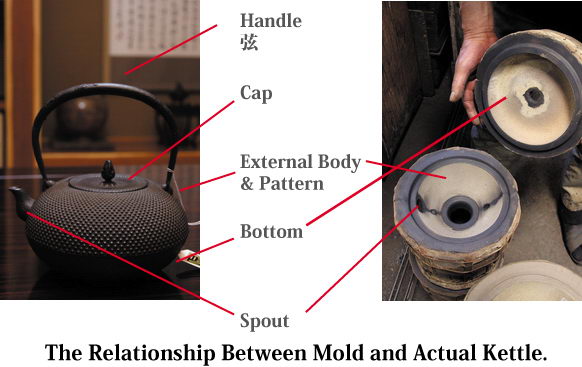
Clay mold is made of sand mixed with natural binder. The binder is made of soft clay that was aged and matured in a water bath. Both materials are from the local mountains and river band. A set of metal plate is used to form the shape of kettle. The shape of metal plate is cut according to the intended shape of kettle. Using metal plate on soft clay, turning just like drawing a circle with a compass, the shape of kettle is formed. The mold for the bottom part of kettle is made according to the same method. The mold for the bottom part has a center hole as this is where molten iron is poured. The pattern is stamped one by one by manual work. It is stumped on the surface of mold while the clay is still soft. When molten iron is poured into the mold, the embossed pattern appears on the surface as it is inside out. There are a few patterns traditionally used for the cast iron kettle.

Once the shape of mold is completed, the patterm is stamped according to the intended design. It is very time consuming work as everything is fully depending on manual work. Traditionally there are 3 major patterns always used for cast iron kettle. In particular, the arare is very typical. The shapeness of arare is depending on how deep stumping is applied and how many times the mold is re-used. In making high-end cast iron kettle, the mold is used only once. In this case, stumping work has to be carried out for each product.
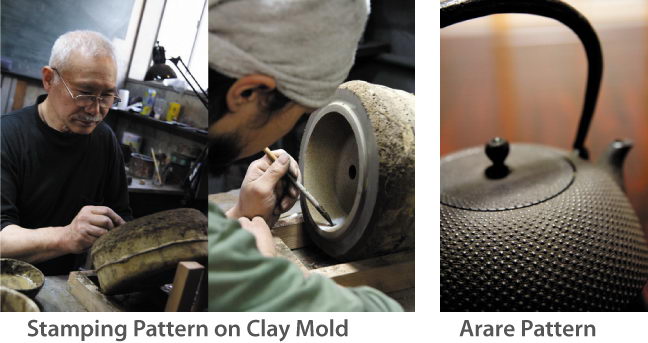
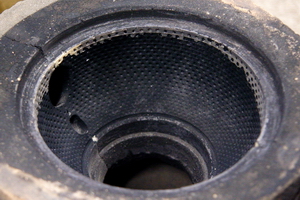
(a) Arare 霰
This is the most typical design of Nanbu. Arare is manually stamped using various sizes of rod. The more vivid the arare pattern appears, the better the quality it is. The sharpness of arare is depending on the workmanship as well as how many times the same mold is recycled. In making high-end arare, the mold is used only once and it is never recycled. On the other hand, when the same mold is recycled over and over again, the arare pattern is getting blurred. There are various sizes of arare: normal size, intermediate size, Kikko (亀甲) and big size which is called Oni-arare (鬼霰). For the big size of arare, the mold often damaged when the cast iron kettle is removed from the mold. Therefore the same mold cannot be re-used.
(b) Hada 肌 - Skin
This is the traditional pattern as well. In addition, the Hada pattern is also applied to the lower half of kettle regardless of its design. It is the rough surface with irregular texture. People often think this is cast without any pattern stamped. However Hada texture is not that simple. It is made of sand ball that is debossed on the mold. The sand has to be sifted to get the ideal mesh size, mixed with clay and made into small ball shape. Then the sand ball is stamped on the mold.

(c) Picture
Traditionally, Flower, Horse, Bird, and Sansui (山水) is used as a motif. At first, the intended pattern has to be either printed or drawn on a piece of paper. The paper is then attached on the surface of clay mold and it is pressed with metal rod according to the motif.
The internal mold is called Nakago (中子). It is used to cast the internal layer of kettle. If kettle is cast without Nakago, kettle will contains a mass of iron and there is no space remains inside the kettle. The difference of the diameter between the external and internal mold is equal to the thickness of the cast iron. The clay mold is made with the same method as making the external mold. Once Nakago is dried, it is ready for casting iron. Nakago is fixed straight up and position exactly in the center of external mold.
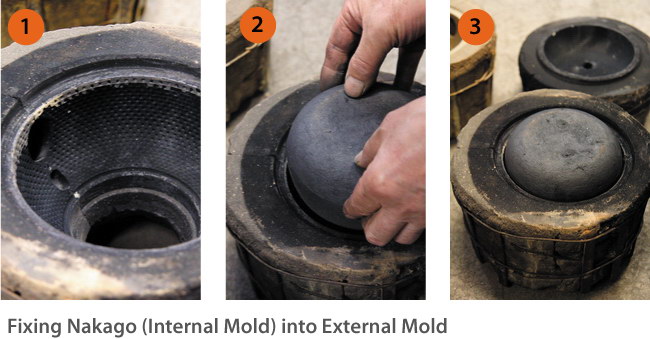
The mold for the spout is made separately. Firstly the artist has to make an archetype for the intended shape of spout using clay and it is baked to harden it. Once archetype is baked, use the archetype for casting the external layer with clay mold and bake it. Taking the external model, the internal mold is cast and baked. When the internal mold is ready, the internal mold is scraped according to the required thickness of the iron.
All the parts of mold for making spout are assembled and fixed into the external mold of kettle. Specify the position of spout and a hole is made on external mold. Then, fix the spout mold into the hole.
If the design of spout is too complicated or the length of spout is very long, the mold has to be destroyed after casting. The spout with complex design can not be removed without destruction of mold. This is the reason that certain shape of kettle such as Nanbu Shape is very expensive.

Once a product is made, the mold will be destroyed. This method is used for very high-end model such as:
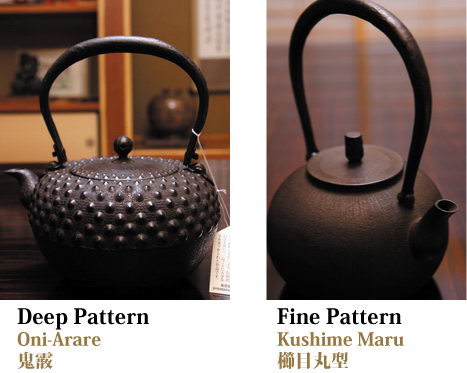
Certain part of mold, in particular the mold for spout gets damaged and need to be repaired each time after casting.
Traditionally some designs such as Nanbu shape uses very long spout. The spout is stuck when trying to remove it from the mold and usually the mold is partially destroyed. It is not based on the luck or technique, but design. After all, the mold can only be reused for a few times.
Some designs such as arare or sand pattern is made with this method. Mold can be recycled for a few times. Usually good brand never recycled more than 4 times as pattern is getting blur. Although using the same mold, the first cast kettle has the most clear and vivid pattern.
Low-end hand-made kettle is made with this method. Using the same clay mold, kettle is cast over and over again sometimes even more than 100 times. If you are very lucky, you may get 1st cast kettle which pattern is sharp and vivid. The product cast from over used mold has very blur in its pattern and easily recognized. Manufacture usually try to introduce a certain design that is less obvious to see the effect of recycling, such as sand pattern: 砂目 or 肌. The more standard design such as Arare is used, the easier being recognized the superiority of casting technique.
For casting the iron kettle, there are 2 different types of iron: normal iron and sand iron. Basically the iron is produced by respective brand. Each brand has own composition of minerals and carbon in the kettle.
This is usually refers to grey cast iron. It is an alloy of carbon, silicon, and iron, contains of 1.7 to 4.5% C and 1 to 3% Si. The advantage of cast iron is more fluid, less shrinkage and the melting point is much lower. The cast iron is produced using coaks, silica, raw material of iron and oxigen. Usually caster control the production based on nothing but the viscosity of molten iron and its sparks. If the production of cast iron is incorrect such as carbon content is too low, the shrinkage of iron is too much and the kettle may simply crack when it is cool down.
During Edo Era, all kinds of cast iron kettle were made of sand iron. At that time, it was the only iron available since there was no other iron manufacturing method like now. Sand iron was processed with the traditional method called Tatara which is also the process of making iron for sword.

For now, the sand iron is very limited and it is difficult for the artist to obtain its raw material. Nowadays, no one is processing sand iron using traditional method. Usually this material is obtained from old sand iron kettle produced in Edo Era. Sometimes if lucky, there is some quantity of sand iron that was kept by the earlier generation. The real sand iron is made of magnetite (Fe3O4 ) which is the small crystal of magnetite. Usually sand iron contains trace amount of titanium and less carbon.
Depending on the alloying element, cast iron will form so-called white cast Iron that has similar character as sand iron. The white cast iron is formed due to some reasons, e.g., the reduction of carbon to below 2%, addition of some minerals or physical shock. The character of white cast iron is very similar to the sand iron and sometimes it is used as “sand iron”. The white cast iron is a different alloy which contains less amount of trace mineral than the real sand iron. For example, sand iron contains titanium. These trace minerals in iron gives more elasticity and flexibility in casting. The white cast iron looks very white, while the real sand iron appears to be a little golden white. Because sand iron gets very seldom rusty, the cast iron kettle made of sand iron is polished or partially polished. Traditionally the cast iron kettle made during Edo Era was not polished. But we can easily recognize the sand iron kettle if we knock it as it gives very high tone.
Sand iron and white cast iron is more brittle than normal cast iron. It is very difficult to handle and in many cases it cracks easily during casting. In fact many used antique sand iron kettles made in Edo Era which remain until now often found with crack at the bottom. Due to difficulty in casting and low yield in production, the cost for sand cast iron kettle is very high.
Go to Detail Explanation about Satetsu Tetsubin>>
Once casting is completed, the iron kettle is baked in charcoal fire. The charcoal fire is burning with less oxygen and it generates carbon monoxide and takes away the oxygen from the surface of iron. The fire reduces iron from Fe3+ into Fe2+. In other word, the surface of iron kettle is activated. Without this process, cast iron kettle is nothing but kettle. It does not really change the taste of water and tea. As a result of this process, the internal surface of kettle becomes blue-gray color. This is the typical color of activated/reduced iron.

There are a few reasons why cast iron kettle is coated.
(i) Prevent the Kettle from Leaking
The structure of cast iron is very porous. The present of some minor holes is inevitable. Usually kettle has minor leakage. Every finished product is inspected and confirmed the position of leakage and the leaking point is spotted and sealed using natural lacquer called Urushi (漆). Urushi is the sap of tree called Urushi. This is the most traditional coating material in Japan. Some wooden furniture coated with Urushi that salvaged from the sunken ship found in deep ocean was remaining intact. The Urushi coating effectively protects the wood from salt-water. Urushi performs like resin when it is applied at high temperature. It hardens and can hardly come out. At the bottom of kettle, the Urushi treated spot appeared in black color while other area remains in blue-gray color.
(ii) Painting Urushi as base coating
Urushi is also applied on the external surface of kettle as a base coating. When the kettle is heated up to 300-400 degree C, the urushi is applied. On the top of base coating, another layer of coating in black or brown color is applied. This coating material is made of Urushi mixed with sand iron. The different brand uses different color and the production technique is kept secret.
(iii) Anti-rust
Occasionally some artists like to paint urushi inside the kettle in order to protect the iron from rusting. However this coating will lessen the reaction of iron with water, yet some people prefer this since the kettle is hardly becomes rusty.
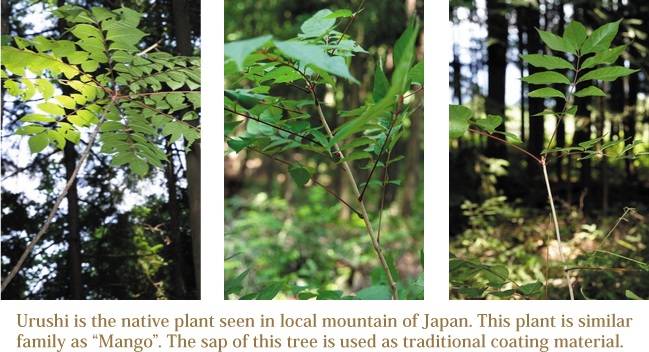

There are 2 different types of handle, hollow and solid. The making of handle is completely different from casting. Handle is made by forging while kettle is made by casting.
(i) Hollow Handle
The hollow handle is used for super high-end kettle. This type of handle is made of iron plate. It is rolled and forged into the intended shape. The handle has a few holes which is called insect bite. This is a fashion and also has a function to cool down the handle. The insect bite hole is the symbol of the hollow type handle. The kettle made with hollow handle is much more expensive than solid handle.
(ii) Solid Handle
The solid handle is used for low to intermediate model. The solid handle is made of iron bar. It is forged into the intended shape. Majority of hand-made kettle in the market has a solid handle. The production cost for solid handle is much cheaper than hollow type. Nowadays we use either gas cooker or IH cooker for heating kettle. The handle never gets hot even if it is made of solid material. As a matter of fact, the type of handle is a fashion and it is the major factor in determining the price and superiority of kettle.
Some handles are made with Silver or Gold Inlay (象嵌). The Kyoto style kettle used silver inlay on either body or handle. Silver inlay can be applied regardless or hollow or solid handle. Nowadays the number of artist who use silver inlay is very limited as there is no more Kyoto style up-to-date. Some Yamagata cast iron kettles are processed with silver inlay as influenced by Kyoto style.

This is refers to the product made in mass production scale. The sand mixed with binder is pressed using aluminum mold. Using it as the sand mold, the products with the same design are cast over and over again. This method was developed for cook ware. But it is also used for making low-end cast iron kettle or tea pot. Most of the cast iron “tea pot” is made with this method. The kettle made with sand mold is different from hand-made kettle in terms of:
The cost of hand-made cast iron kettle is very high as the clay mold can only be used for very limited times. It consumes a lot of times to develop the mold and stamp various patterns. As for the non-hand-made kettle with sand mold, the same mold is recycled uncountable time.

Traditionally cast iron tetsubin was heated by charcoal fire. The charcoal fire does not generate moisture and it will not cause rust at the bottom of tetsubin. If using a gas cooker, it generates Carbon Dioxide and water when it is burning. In a long run, the bottom part of iron tetsubin becomes rusty. However it is a very natural change. The rust only appears on its surface and it does not cause any harm to the material. If you do not like it, you can apply green tea on it to reduce the rust and it will turn to dark color. Somehow many Japanese customers rather appreciate the change of color in the long run. It is kind of Wabi-Sab. It will form very classical color which makes your tetsubin very identical.
Please note that the induction heater can not be used for the small kettle which the diameter of bottom area is less than 80mm. The manufacturer recommends not using too strong heat on induction heater. This is because the induction heater gives very localized-heat. When it is heated on the induction heater, the iron locally expands and when it is cooled down, it shrinks. The intense heat will give stress to the metal and the kettle cannot last up to 50 years of usage. In particular, sand cast iron is more brittle than normal cast iron. It must not be heated with intense heat on the induction heater.
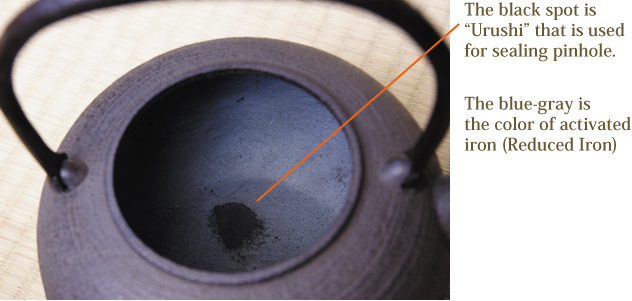
Usually tetsubin has 2 circular spots at its bottom part. It is the trace where “katamochi” was located. Katamochi is the 2 nails that used to fix the internal mold (nakago) during casting. Thus tetsubin has 2 holes on its bottom. These holes are sealed with material that is prepared mixing urushi with iron sands.
When cast iron tetsubin is heated on induction heater, these 2 spots tend to be over heated. Due to the nature of the material used on these spots, it gets hotter than cast iron. Therefore it is necessary to start heating at very low output if induction heater is used.
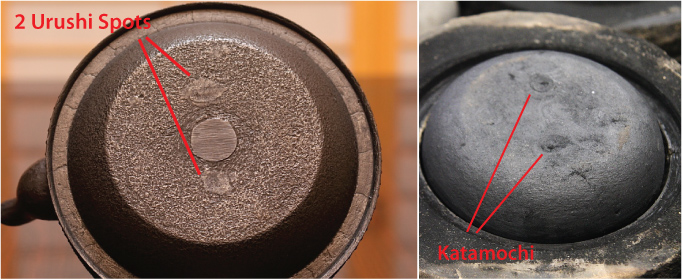

There is a noticeable number of Kyoto style tetsubins in Asia market such as Kibun-Do (亀文堂) and Ryumon-Do (龍文堂). Ryumon-Do (龍文堂) is the very old workshop started in year 1764. It was the first brand who invented wax mold in casting the iron tetsubin. Taking the advantage of wax mold that enables the making 3 dimensional designs, Ryumon-Do’s product has very gorgeous carving on its surface. The Kibun-Do (亀文堂) was set up in Shiga prefecture by the student of Ryumon-Do. Both workshops produced a number of products in the history, yet disappeared.
Many people were told and believed these two workshops were the most prestigious and high-end brand in Japan as these products are very common in Asia. Nowadays these 2 brands always appear in the auction. These products are purchased by Taiwan Company, reconditioned and introduced to the market. Due to the gorgeous carving and silver inlay, people spontaneously take it as a high-end product. In fact, these products are just one of the styles. Usually Kyoto style kettles reaches the end-users at shop after it has gone though too many channels, therefore the price is pretty high.
A number of tetsubin being sold and claimed to be antique piece were often covered with a thick layer of rust in the interior. In fact, used tetsubin seldom gets rusty up to that extent. The tetsubin in such conditions showed that it was not correctly used for a long time or purposely made in such a condition in order to imitate the appearance of an aged tetsubin. Usually under the normal usage, only a thin layer of rust stays on the surface. The excessively rusted interior no longer retains ferric, but ferrous. In addition, it is doubtful that terribly rusty surface has the same porosity. It would give a very different effect in taste compared to the original condition. In this regard, it is not true that old tetsubin performs better.
However there is an exceptional case. There is very limited number of old tetsubin which performs pretty well. In the old days, the casting technique was different. During the Edo era, all tetsubins were made of Satetsu (Sand Iron). As I mentioned earlier, satetsu tetsubin gives a good effect in taste and flavor thanks to its porosity. However those antique satetsu tetsubins are very brittle. Most of them cracked after long period of usage. We could hardly find an authentic satetsu tetsubin that is made during Edo era and remained until today. There is less reason to look for an old tetsubin considering that there are existing brands producing very good quality and also satetsu tetsubin is being continuously produced until today.
The old tetsubin tends to have a very thick layer of scale inside. It was built by the previous user. People appreciate it as they believe it changes the taste more effectively. However the scale must be formed with your own water. In fact, the scale that is formed earlier by another person does not give a positive effect. As a conclusion, it is wise to consider a new model rather than a used model, unless it is for display or decoration purpose.
As I mentioned earlier, old tetsubin does not give a higher value due to its condition, unless it’s a good design made by famous artist and was kept in a very good condition, it is highly valued as an antique piece. At the same time, there are a lot of hidden risks; sometimes unaware leaking or crack is found on old tetsubin. We suggest customer to consider high-end model made by famous artist in modern day. Since you know its origin and the artist better, you can foresee the value of it in future rather than gambling with antique model that its origin information is ambiguous.
In general, most of the hand-made cast iron tea ware is a “kettle”. The majority of tea pot is commercially made in mass production process. The major difference is as follow.
Basically the answer is “No”. The cast iron and glazing material will expand when it is heated. But the ratio of expansion is different between these materials. Sometimes it causes crack on glazing material. In addition, there is always a risk of heating the empty tea pot. The moment the cast iron tea pot is heated without water inside, the glazed material will melt as its melting point is much lower than cast iron. This question is referring to the "teapot". For cast iron tetsubin, of course it is fine to place it on fire.
Most of the damages can be repaired, e.g. if the tetsubin becomes very rusty, there is a minor hole, cap becomes dented or lost or some parts are cracked. As HOJO is directly dealing with the manufacturer, we are able to provide professional service after sales. If repairing is required by manufacturer, we need customer to bear the shipping cost and repairing fee. We do not charge any profit on the repairing work.
Tetsubin MUST NOT be heated when there is no water inside. The temperature of tetsubin goes higher than 100 degree C if there is no water inside. If water is remained inside, the temperature of tetsubin will be less than 100 degree C no matter how much it is heated. Once the temperature goes higher than 100 degree C, it burns the 2 urushi spots that are located at the bottom of tetsubin. As a result, it causes leaking and in the worst case, it causes crack of tetsubin. Sometimes we receive tetsubin from customer claiming that tetsubin was leaking. If we examine the condition of the 2 urushi spots, we will find out whether or not it is caused due to the excessive heating. If tetsubin is heated without water inside, the 2 urushi spots are peeling off.

 |
We accept various kinds of credit card through Paypal.
Only if customer prefer other option of payment, we suggest "Bank Transfer".
Various choice of shippping method
EMS, SAL, Small Packet, Small Packet (SAL) Yamato Express and Surface
For shipping tea, we usually suggest small air parcel, the estimated shipping cost of tea in 100g (with wrapping material ) is
Small Parcel
USA JPY 600, EU JPY600 and Asia JPY470
Small Packet (SAL)
USA JPY380, EU JPY380 and Asia JPY320
The shipping fee to oversea by small air parcel happens to be even cheaper than domestic shipping fee in Japan.
For your information, some countries, EU in particular imposes custom duty. We need buyer to bare the duty. We are sorry, but we cannot change the amount on the invoice, and we do not mark any packages as gifts. We will strictly follow the custom regulation.